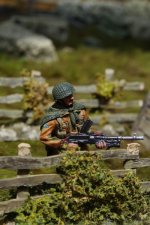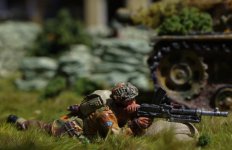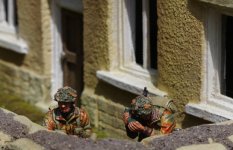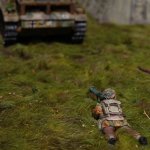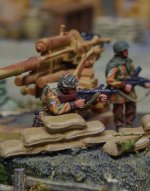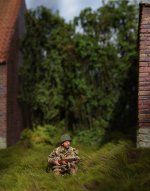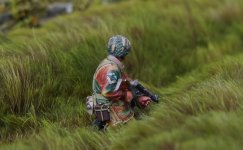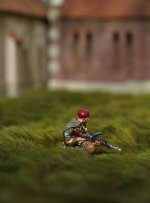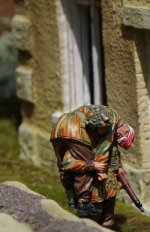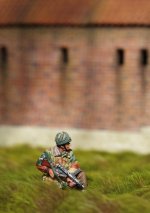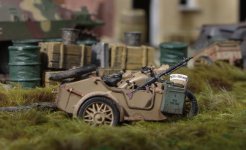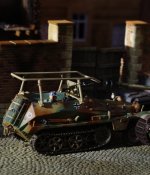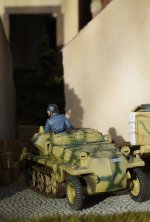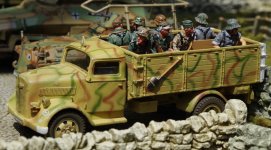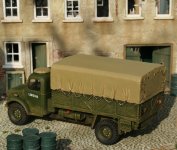You are using an out of date browser. It may not display this or other websites correctly.
You should upgrade or use an alternative browser.
You should upgrade or use an alternative browser.
Battle for Arnhem.... (4 Viewers)
- Thread starter panda1gen
- Start date
panda1gen
Lieutenant Colonel
- Joined
- Jul 29, 2005
- Messages
- 7,092
Louis Badolato
Lieutenant General
- Joined
- Apr 25, 2005
- Messages
- 18,068
Kevin,
It's about time! You've been slacking off lately! lol
It's about time! You've been slacking off lately! lol
panda1gen
Lieutenant Colonel
- Joined
- Jul 29, 2005
- Messages
- 7,092
panda1gen
Lieutenant Colonel
- Joined
- Jul 29, 2005
- Messages
- 7,092
But there is always the artillery ......
e.g. Polish 4.2 in mortar crew .....
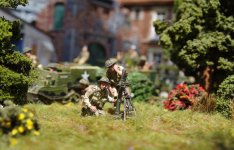
Ref: From Wikipedia
The Ordnance ML 4.2-inch mortar was a heavy mortar used by the British Army during and after World War II.
The 4.2 in (110 mm) mortar was a smooth-bore weapon of the Stokes pattern and was designed by the Armaments Research and Development Establishment and produced by the Royal Ordnance Factories.[5]
It entered widespread British service in 1942, equipping chemical warfare companies of the Royal Engineers (RE). The Mark 3 became the standard model.
The first combat use was at Second Battle of El Alamein, when the 66th Mortar Company (RE) was attached to the Australian 24th Infantry Brigade.
During the battle, 66 Mortar Company provided intense, effective supporting fire on the 24th Brigade's exposed right flank, as the infantry advanced, expending all of the 4.2 in (110 mm) HE mortar ammunition in the theatre.
Around mid-1943, the Royal Engineer chemical warfare companies were disbanded as an emergency expedient and one heavy mortar company of each infantry division machine-gun battalion was equipped with the mortar.
This company was organized with sixteen 4.2 in (110 mm) mortars, in four platoons of four mortars each.
In early 1944, divisions in Italy also held a pool of mortars for issue to other units as needed, usually troops in the divisional anti-tank regiment, some regiments even converted one or more batteries to mortars.
Ordnance ML 4.2 in (110 mm) mortars were slower to reach Commonwealth forces in the Pacific and Asia. Australian Army units in the South West Pacific theatre were reportedly the first to receive them, before forces in Burma.[citation needed]
Description
The 4.2 in (110 mm) mortar entered production at the end of 1941 with a standard base plate and tripod. The normal detachment was six men and it was transported with ammunition in a 10 cwt (1,120 lb (510 kg)) trailer, usually towed behind a Loyd Carrier.
There was also an auxiliary base plate that fitted around it, to increase its area for use on softer ground. Later an integrated trailer/base plate was developed, called the Mk 1 Mobile Baseplate.
The wheels, which were on suspension arms, were unlocked and raised for firing; the Mk1/1 had detachable wheels and the barrel with tripod attached, was stowed on top for towing.
The mobile base plate trailer mounting could be brought into action by 2 men.[5] Regarding rate of fire, one source reports a crew putting 23 bombs in the air before the first impacted.[7]
Ammunition
Both HE (9.1 kg (20 lb)) and smoke (10.2 kg (22 lb)) ammunition was used. Smoke included WP and Base Ejection, and in World War II other types for practice.
Two charges were available. In World War II, both streamlined and cylindrical bombs were available.
Chemical munitions included the MK I chemical mortar bomb with Mustard gas (HS or HT fillings).
Users
World War II
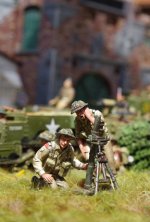
e.g. Polish 4.2 in mortar crew .....

Ref: From Wikipedia
The Ordnance ML 4.2-inch mortar was a heavy mortar used by the British Army during and after World War II.
The 4.2 in (110 mm) mortar was a smooth-bore weapon of the Stokes pattern and was designed by the Armaments Research and Development Establishment and produced by the Royal Ordnance Factories.[5]
It entered widespread British service in 1942, equipping chemical warfare companies of the Royal Engineers (RE). The Mark 3 became the standard model.
The first combat use was at Second Battle of El Alamein, when the 66th Mortar Company (RE) was attached to the Australian 24th Infantry Brigade.
During the battle, 66 Mortar Company provided intense, effective supporting fire on the 24th Brigade's exposed right flank, as the infantry advanced, expending all of the 4.2 in (110 mm) HE mortar ammunition in the theatre.
Around mid-1943, the Royal Engineer chemical warfare companies were disbanded as an emergency expedient and one heavy mortar company of each infantry division machine-gun battalion was equipped with the mortar.
This company was organized with sixteen 4.2 in (110 mm) mortars, in four platoons of four mortars each.
In early 1944, divisions in Italy also held a pool of mortars for issue to other units as needed, usually troops in the divisional anti-tank regiment, some regiments even converted one or more batteries to mortars.
Ordnance ML 4.2 in (110 mm) mortars were slower to reach Commonwealth forces in the Pacific and Asia. Australian Army units in the South West Pacific theatre were reportedly the first to receive them, before forces in Burma.[citation needed]
Description
The 4.2 in (110 mm) mortar entered production at the end of 1941 with a standard base plate and tripod. The normal detachment was six men and it was transported with ammunition in a 10 cwt (1,120 lb (510 kg)) trailer, usually towed behind a Loyd Carrier.
There was also an auxiliary base plate that fitted around it, to increase its area for use on softer ground. Later an integrated trailer/base plate was developed, called the Mk 1 Mobile Baseplate.
The wheels, which were on suspension arms, were unlocked and raised for firing; the Mk1/1 had detachable wheels and the barrel with tripod attached, was stowed on top for towing.
The mobile base plate trailer mounting could be brought into action by 2 men.[5] Regarding rate of fire, one source reports a crew putting 23 bombs in the air before the first impacted.[7]
Ammunition
Both HE (9.1 kg (20 lb)) and smoke (10.2 kg (22 lb)) ammunition was used. Smoke included WP and Base Ejection, and in World War II other types for practice.
Two charges were available. In World War II, both streamlined and cylindrical bombs were available.
Chemical munitions included the MK I chemical mortar bomb with Mustard gas (HS or HT fillings).
Users
World War II

panda1gen
Lieutenant Colonel
- Joined
- Jul 29, 2005
- Messages
- 7,092
Louis, a response to your comment on the K&C thread about the PIAT.
Recommend ref: https://en.wikipedia.org/wiki/PIAT
The Projector, Infantry, Anti Tank (PIAT) Mk I was a British man-portable anti-tank weapon developed during the Second World War. The PIAT was designed in 1942 in response to the British Army's need for a more effective infantry anti-tank weapon and entered service in 1943.
The PIAT was based on the spigot mortar system, and projected (launched) a 2.5 pound (1.1 kg) shaped charge bomb using a cartridge in the tail of the projectile.[5]
It possessed an effective range of approximately 115 yards (105 m)[3] in a direct fire anti-tank role, and 350 yards (320 m)[3] in an indirect fire role.
The PIAT had several advantages over other infantry anti-tank weapons of the period: it had greatly increased penetration power over the previous anti-tank rifles, it had no back-blast which might reveal the position of the user or accidentally injure friendly soldiers around the user, and it was simple in construction.
However, the device also had some disadvantages: powerful recoil, a difficulty in cocking the weapon, and early problems with ammunition reliability.
Lieutenant Colonel Stewart Blacker was developing a platoon mortar. However, rather than using the conventional system of firing the mortar shell from a barrel fixed to a baseplate, Blacker wanted to use the spigot mortar system. Instead of a barrel, there was a steel rod known as a "spigot" fixed to a baseplate, and the bomb itself had a propellant charge inside its tail. When the mortar was to be fired, the bomb was pushed down onto the spigot, which exploded the propellant charge and blew the bomb into the air.[10]
By effectively putting the barrel on the inside of the weapon, the barrel diameter was no longer a limitation on the warhead size.[11]
Blacker eventually designed a lightweight mortar that he named the "Arbalest" and submitted it to the War Office,[12] but it was turned down in favour of a Spanish design.
Undeterred, however, Blacker continued with his experiments and decided to try to invent a hand-held anti-tank weapon based on the spigot design, but found that the spigot could not generate sufficient velocity needed to penetrate armour.
But he did not abandon the design, and eventually came up with the Blacker Bombard, a swivelling spigot-style system that could launch a 20-pound (9 kg) bomb approximately 100 yards (90 m). Although the bombs it fired could not actually penetrate armour, they could still severely damage tanks, and in 1940 a large number of Blacker Bombards were issued to the Home Guard as anti-tank weapons.[13]
When Blacker became aware of the existence of shaped charge ammunition, he realized that it was exactly the kind of ammunition he was looking for to develop a hand-held anti-tank weapon, as it depended upon the energy contained within itself, and not the sheer velocity at which it was fired.[14]
Blacker then developed a shaped charge bomb with a propellant charge in its tail, which fitted into a shoulder-fired launcher that consisted of a metal casing containing a large spring and a spigot; the bomb was placed into a trough at the front of the casing, and when the trigger was pulled the spigot rammed into the tail of the bomb and fired it out of the casing and up to approximately 140 metres (150 yd) away.
Blacker called the weapon the "Baby Bombard", and presented it to the War Office in 1941.[14] However, when the weapon was tested it proved to have a host of problems; a War Office report of June 1941 stated that the casing was flimsy and the spigot itself did not always fire when the trigger was pulled, and none of the bombs provided exploded upon contact with the target.[15]
At the time that he developed the Baby Bombard and sent it off the War Office, Blacker was working for a government department known as MD1, which was given the task of developing and delivering weapons for use by guerrilla and resistance groups in Occupied Europe.[1]
Shortly after the trial of the Baby Bombard, Blacker was posted to other duties, and left the anti-tank weapon in the hands of a colleague in the department, Major Millis Jefferis.[1]
Jefferis took the prototype Baby Bombard apart on the floor of his office in MD1 and rebuilt it, and then combined it with a shaped charge mortar bomb to create what he called the "Jefferis Shoulder Gun".
Jefferis then had a small number of prototype armour-piercing high-explosive anti-tank (HEAT) rounds made, and took the weapon to be tested at the Small Arms School at Bisley.[16]
A warrant officer took the Shoulder Gun down to a firing range, aimed it at an armoured target, and pulled the trigger; the Shoulder Gun pierced a hole in the target, but also wounded the warrant officer when a piece of metal from the exploding round flew back and hit him.[16]
Jefferis himself then took the place of the warrant officer and fired off several more rounds, all of which pierced the armoured target but without wounding him.
Impressed with the weapon, the Ordnance Board of the Small Arms School had the faults with the ammunition corrected, renamed the Shoulder Gun as the Projector, Infantry, Anti Tank, and ordered that it be issued to infantry units as a hand-held anti-tank weapon.[17]
Production of the PIAT began at the end of August 1942.[1]

Recommend ref: https://en.wikipedia.org/wiki/PIAT
The Projector, Infantry, Anti Tank (PIAT) Mk I was a British man-portable anti-tank weapon developed during the Second World War. The PIAT was designed in 1942 in response to the British Army's need for a more effective infantry anti-tank weapon and entered service in 1943.
The PIAT was based on the spigot mortar system, and projected (launched) a 2.5 pound (1.1 kg) shaped charge bomb using a cartridge in the tail of the projectile.[5]
It possessed an effective range of approximately 115 yards (105 m)[3] in a direct fire anti-tank role, and 350 yards (320 m)[3] in an indirect fire role.
The PIAT had several advantages over other infantry anti-tank weapons of the period: it had greatly increased penetration power over the previous anti-tank rifles, it had no back-blast which might reveal the position of the user or accidentally injure friendly soldiers around the user, and it was simple in construction.
However, the device also had some disadvantages: powerful recoil, a difficulty in cocking the weapon, and early problems with ammunition reliability.
Lieutenant Colonel Stewart Blacker was developing a platoon mortar. However, rather than using the conventional system of firing the mortar shell from a barrel fixed to a baseplate, Blacker wanted to use the spigot mortar system. Instead of a barrel, there was a steel rod known as a "spigot" fixed to a baseplate, and the bomb itself had a propellant charge inside its tail. When the mortar was to be fired, the bomb was pushed down onto the spigot, which exploded the propellant charge and blew the bomb into the air.[10]
By effectively putting the barrel on the inside of the weapon, the barrel diameter was no longer a limitation on the warhead size.[11]
Blacker eventually designed a lightweight mortar that he named the "Arbalest" and submitted it to the War Office,[12] but it was turned down in favour of a Spanish design.
Undeterred, however, Blacker continued with his experiments and decided to try to invent a hand-held anti-tank weapon based on the spigot design, but found that the spigot could not generate sufficient velocity needed to penetrate armour.
But he did not abandon the design, and eventually came up with the Blacker Bombard, a swivelling spigot-style system that could launch a 20-pound (9 kg) bomb approximately 100 yards (90 m). Although the bombs it fired could not actually penetrate armour, they could still severely damage tanks, and in 1940 a large number of Blacker Bombards were issued to the Home Guard as anti-tank weapons.[13]
When Blacker became aware of the existence of shaped charge ammunition, he realized that it was exactly the kind of ammunition he was looking for to develop a hand-held anti-tank weapon, as it depended upon the energy contained within itself, and not the sheer velocity at which it was fired.[14]
Blacker then developed a shaped charge bomb with a propellant charge in its tail, which fitted into a shoulder-fired launcher that consisted of a metal casing containing a large spring and a spigot; the bomb was placed into a trough at the front of the casing, and when the trigger was pulled the spigot rammed into the tail of the bomb and fired it out of the casing and up to approximately 140 metres (150 yd) away.
Blacker called the weapon the "Baby Bombard", and presented it to the War Office in 1941.[14] However, when the weapon was tested it proved to have a host of problems; a War Office report of June 1941 stated that the casing was flimsy and the spigot itself did not always fire when the trigger was pulled, and none of the bombs provided exploded upon contact with the target.[15]
At the time that he developed the Baby Bombard and sent it off the War Office, Blacker was working for a government department known as MD1, which was given the task of developing and delivering weapons for use by guerrilla and resistance groups in Occupied Europe.[1]
Shortly after the trial of the Baby Bombard, Blacker was posted to other duties, and left the anti-tank weapon in the hands of a colleague in the department, Major Millis Jefferis.[1]
Jefferis took the prototype Baby Bombard apart on the floor of his office in MD1 and rebuilt it, and then combined it with a shaped charge mortar bomb to create what he called the "Jefferis Shoulder Gun".
Jefferis then had a small number of prototype armour-piercing high-explosive anti-tank (HEAT) rounds made, and took the weapon to be tested at the Small Arms School at Bisley.[16]
A warrant officer took the Shoulder Gun down to a firing range, aimed it at an armoured target, and pulled the trigger; the Shoulder Gun pierced a hole in the target, but also wounded the warrant officer when a piece of metal from the exploding round flew back and hit him.[16]
Jefferis himself then took the place of the warrant officer and fired off several more rounds, all of which pierced the armoured target but without wounding him.
Impressed with the weapon, the Ordnance Board of the Small Arms School had the faults with the ammunition corrected, renamed the Shoulder Gun as the Projector, Infantry, Anti Tank, and ordered that it be issued to infantry units as a hand-held anti-tank weapon.[17]
Production of the PIAT began at the end of August 1942.[1]

panda1gen
Lieutenant Colonel
- Joined
- Jul 29, 2005
- Messages
- 7,092
Design

In firing, the pin moves forward into the round, the round is fired pushing the rod back against the spring and cocking it again.
The PIAT was 39 inches (0.99 m) long and weighed 32 pounds (15 kg), with an effective direct fire range of approximately 115 yards (105 m) and a maximum indirect fire range of 350 yards (320 m).[3]
It could be carried and operated by one man,[3] but was usually assigned to a two-man team,[21] the second man acting as an ammunition carrier and loader. The body of the PIAT launcher was a tube constructed out of thin sheets of steel, containing the spigot mechanism, trigger mechanism and firing spring.
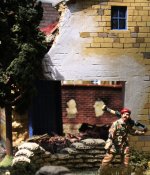
At the front of the launcher was a small trough in which the bomb was placed, and the movable spigot ran along the axis of the launcher and into the trough.[8] Padding for the user's shoulder was fitted to the other end of the launcher, and rudimentary aperture sights were fitted on top for aiming; the bombs launched by the PIAT possessed hollow tubular tails, into which a small propellant cartridge was inserted, and shaped charge warheads.[8]
Conventional spigot mortar designs have a fixed spigot rod, for example the Blacker Bombard. The moving spigot rod in the PIAT design was unusual, and served to help reduce recoil sufficiently to make it a viable shoulder fired weapon.[3]
The PIAT was a little lighter by about 1 kg (2 lb 3 oz) and about 0.6 m (2.0 ft) shorter than its predecessor, the Boys anti-tank rifle, although it was heavier than the 18 lb (8.2 kg) bazooka.
To prepare the weapon for firing the spigot mechanism, which was operated by a large spring, had to be cocked, and to do this was a difficult and awkward process.
The user had to first place the PIAT on its butt, then step on both sides of the shoulder padding (a la Pogo stick) and quarter-turn the weapon to unlock the body and simultaneously lock the spigot rod to the butt; the user would then have to bend over and pull the body of the weapon upwards, thereby pulling the spring back until it attached to the trigger sear and cocking the weapon.
Once this was achieved, the body was then lowered and quarter-turned to reattach it to the rest of the weapon, and the PIAT could then be fired.[22]
Users of a small stature often found the cocking sequence challenging, as they did not have the sufficient height required to pull the body up far enough to cock the weapon; it was also difficult to do when lying in a prone position, as was often the case when using the weapon in action.[23]
Note, however, that troops were trained to cock the PIAT before expected use, and "in action the projector will always be carried cocked" (but unloaded).[3]
Unless a stoppage occurred, or the shooter did not maintain their hold as the weapon recoiled,[24] it would not normally be necessary to manually re-cock the weapon in action.
When the trigger was pulled, the spring pushed the spigot rod (which has a fixed firing pin on the end) forwards into the bomb, which aligned the bomb, ignited the propellant cartridge in the bomb and launched it along the rod and into the air.
The recoil caused by the detonation of the propellant blew the spigot rod backwards onto the spring, similar to that of a blowback operation; this reduced the shock of recoil and automatically cocked the weapon for subsequent shots, eliminating the need to manually re-cock.[8][22]


In firing, the pin moves forward into the round, the round is fired pushing the rod back against the spring and cocking it again.
The PIAT was 39 inches (0.99 m) long and weighed 32 pounds (15 kg), with an effective direct fire range of approximately 115 yards (105 m) and a maximum indirect fire range of 350 yards (320 m).[3]
It could be carried and operated by one man,[3] but was usually assigned to a two-man team,[21] the second man acting as an ammunition carrier and loader. The body of the PIAT launcher was a tube constructed out of thin sheets of steel, containing the spigot mechanism, trigger mechanism and firing spring.

At the front of the launcher was a small trough in which the bomb was placed, and the movable spigot ran along the axis of the launcher and into the trough.[8] Padding for the user's shoulder was fitted to the other end of the launcher, and rudimentary aperture sights were fitted on top for aiming; the bombs launched by the PIAT possessed hollow tubular tails, into which a small propellant cartridge was inserted, and shaped charge warheads.[8]
Conventional spigot mortar designs have a fixed spigot rod, for example the Blacker Bombard. The moving spigot rod in the PIAT design was unusual, and served to help reduce recoil sufficiently to make it a viable shoulder fired weapon.[3]
The PIAT was a little lighter by about 1 kg (2 lb 3 oz) and about 0.6 m (2.0 ft) shorter than its predecessor, the Boys anti-tank rifle, although it was heavier than the 18 lb (8.2 kg) bazooka.
To prepare the weapon for firing the spigot mechanism, which was operated by a large spring, had to be cocked, and to do this was a difficult and awkward process.
The user had to first place the PIAT on its butt, then step on both sides of the shoulder padding (a la Pogo stick) and quarter-turn the weapon to unlock the body and simultaneously lock the spigot rod to the butt; the user would then have to bend over and pull the body of the weapon upwards, thereby pulling the spring back until it attached to the trigger sear and cocking the weapon.
Once this was achieved, the body was then lowered and quarter-turned to reattach it to the rest of the weapon, and the PIAT could then be fired.[22]
Users of a small stature often found the cocking sequence challenging, as they did not have the sufficient height required to pull the body up far enough to cock the weapon; it was also difficult to do when lying in a prone position, as was often the case when using the weapon in action.[23]
Note, however, that troops were trained to cock the PIAT before expected use, and "in action the projector will always be carried cocked" (but unloaded).[3]
Unless a stoppage occurred, or the shooter did not maintain their hold as the weapon recoiled,[24] it would not normally be necessary to manually re-cock the weapon in action.
When the trigger was pulled, the spring pushed the spigot rod (which has a fixed firing pin on the end) forwards into the bomb, which aligned the bomb, ignited the propellant cartridge in the bomb and launched it along the rod and into the air.
The recoil caused by the detonation of the propellant blew the spigot rod backwards onto the spring, similar to that of a blowback operation; this reduced the shock of recoil and automatically cocked the weapon for subsequent shots, eliminating the need to manually re-cock.[8][22]

Louis Badolato
Lieutenant General
- Joined
- Apr 25, 2005
- Messages
- 18,068
Great description of the process of operating a PIAT. George MacDonald Frasier described laying on his back while cocking it, rather than standing (as you indicated, a la a pogo stick) which kept the operator from being exposed to enemy fire will cocking it. He also indicated that it often did not automatically recock itself when fired, so frequently had to be re-cocked manually.Design
View attachment 352209
In firing, the pin moves forward into the round, the round is fired pushing the rod back against the spring and cocking it again.
The PIAT was 39 inches (0.99 m) long and weighed 32 pounds (15 kg), with an effective direct fire range of approximately 115 yards (105 m) and a maximum indirect fire range of 350 yards (320 m).[3]
It could be carried and operated by one man,[3] but was usually assigned to a two-man team,[21] the second man acting as an ammunition carrier and loader. The body of the PIAT launcher was a tube constructed out of thin sheets of steel, containing the spigot mechanism, trigger mechanism and firing spring.
View attachment 352211
At the front of the launcher was a small trough in which the bomb was placed, and the movable spigot ran along the axis of the launcher and into the trough.[8] Padding for the user's shoulder was fitted to the other end of the launcher, and rudimentary aperture sights were fitted on top for aiming; the bombs launched by the PIAT possessed hollow tubular tails, into which a small propellant cartridge was inserted, and shaped charge warheads.[8]
Conventional spigot mortar designs have a fixed spigot rod, for example the Blacker Bombard. The moving spigot rod in the PIAT design was unusual, and served to help reduce recoil sufficiently to make it a viable shoulder fired weapon.[3]
The PIAT was a little lighter by about 1 kg (2 lb 3 oz) and about 0.6 m (2.0 ft) shorter than its predecessor, the Boys anti-tank rifle, although it was heavier than the 18 lb (8.2 kg) bazooka.
To prepare the weapon for firing the spigot mechanism, which was operated by a large spring, had to be cocked, and to do this was a difficult and awkward process.
The user had to first place the PIAT on its butt, then step on both sides of the shoulder padding (a la Pogo stick) and quarter-turn the weapon to unlock the body and simultaneously lock the spigot rod to the butt; the user would then have to bend over and pull the body of the weapon upwards, thereby pulling the spring back until it attached to the trigger sear and cocking the weapon.
Once this was achieved, the body was then lowered and quarter-turned to reattach it to the rest of the weapon, and the PIAT could then be fired.[22]
Users of a small stature often found the cocking sequence challenging, as they did not have the sufficient height required to pull the body up far enough to cock the weapon; it was also difficult to do when lying in a prone position, as was often the case when using the weapon in action.[23]
Note, however, that troops were trained to cock the PIAT before expected use, and "in action the projector will always be carried cocked" (but unloaded).[3]
Unless a stoppage occurred, or the shooter did not maintain their hold as the weapon recoiled,[24] it would not normally be necessary to manually re-cock the weapon in action.
When the trigger was pulled, the spring pushed the spigot rod (which has a fixed firing pin on the end) forwards into the bomb, which aligned the bomb, ignited the propellant cartridge in the bomb and launched it along the rod and into the air.
The recoil caused by the detonation of the propellant blew the spigot rod backwards onto the spring, similar to that of a blowback operation; this reduced the shock of recoil and automatically cocked the weapon for subsequent shots, eliminating the need to manually re-cock.[8][22]
View attachment 352210
panda1gen
Lieutenant Colonel
- Joined
- Jul 29, 2005
- Messages
- 7,092
Tactical training emphasized that it was best used with surprise and concealment on the side of the PIAT team, and where possible enemy armoured vehicles should be engaged from the flank or rear.[25]
Due to the short engagement distances and the power of the bomb, the crew could be in the bomb blast zone so hard cover was desirable; on open training grounds this might be a slit trench.[3]
The PIAT was often also used in combat to knock out enemy positions located in houses and bunkers.[25]
It was officially given an additional role as an ad-hoc crude mortar, by placing the shoulder pad of the weapon on the ground and supporting it: one rifleman considered it a more effective infantry mortar than the official [two-inch mortar]].[26]
Despite the difficulties in cocking and firing the weapon, it did have several advantages.
The Spigot mortar design allowed a large calibre powerful shaped charge bomb[8] giving greatly increased penetration power over the previous anti-tank rifles, allowing it to remain effective for the rest of the war; its construction was relatively simple and robust without a conventional barrel; there was no back-blast (unlike the contemporary American bazooka) that might endanger friendly troops and give the user's position away, this also meant that the PIAT could be used in confined spaces as in urban warfare; compared to the previous anti-tank rifles the muzzle blast was minimal, also a potential concealment issue.
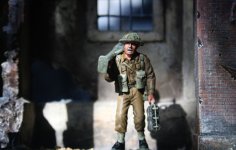
However, the weapon did have drawbacks. It was very heavy and bulky, which meant that it was often unpopular with infantry required to carry it.[21] There were also problems with early ammunition reliability and accuracy.
Although the PIAT was theoretically able to penetrate approximately 100 millimetres (4 in) of armour, field experience during the Allied invasion of Sicily, which was substantiated by trials conducted during 1944, demonstrated that this capability was often nullified by problems of accuracy and round reliability. During these trials, a skilled user was unable to hit a target more than 60% of the time at 100 yards (90 m), and faulty fuses meant that only 75% of the bombs fired detonated on-target.[9]
Ammunition and effect
The PIATs' ammunition used the shaped charge principle, which, if the often unreliable early round design delivered it correctly to the target, allowed the warhead to penetrate almost all enemy armour types at close range.[27]
The following ammunition types were available in 1943.[3]
Getting the bomb to detonate reliably against angled targets was troublesome and was addressed with revised fusing.
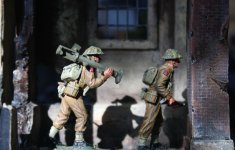
See also the bazooka, which had similar early problems.
The 1943 manual simply describes the service bomb as "H.E." or "HE/AT" and does not mention shaped charge as such. It notes that the bomb has "Excellent penetration. The bomb can penetrate the armour of the latest known types of enemy A.F.Vs. and a considerable thickness of reinforced concrete". It also notes that it may be used "as a house-breaker".
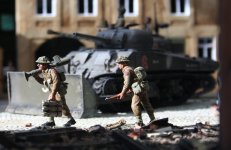
World War II
The PIAT was used in all theatres in which British and other Commonwealth forces served.[16]
It entered service in early-1943, and was first used in action in March near Majaz al Bab during the Tunisia Campaign.[28][29][30] The 1944 war establishment for a British platoon, which contained 36 men, had a single PIAT attached to the platoon headquarters, alongside a 2-inch (51 mm) mortar detachment.[31] Three PIATs were issued to every company at the headquarters level for issuing at the CO discretion – allowing one weapon for each platoon.[25] British Army and Royal Marines commandos were also issued with PIATs and used them in action.[32]
In Australian Army service, the PIAT was also known as "Projector Infantry Tank Attack" (PITA). From 1943, one PIAT team was allocated to each infantry platoon in a jungle division[33] – the tropical light infantry formation that was the standard front-line Australian division in the South West Pacific theatre. It was used against Japanese tanks, other vehicles and fortifications during the Borneo campaign of 1945.
A contemporary (1944–45) Canadian Army survey questioned 161 army officers, who had recently left combat, about the effectiveness of 31 different infantry weapons. In that survey the PIAT was ranked the most "outstandingly effective" weapon, followed by the Bren gun.[34]
An analysis by British staff officers of the initial period of the Normandy campaign found that 7% of all German tanks destroyed by British forces were knocked out by PIATs, compared to 6% by rockets fired by aircraft. However, they also found that once German tanks had been fitted with armoured skirts that detonated shaped charge ammunition before it could penetrate the tank's armour, the weapon became much less effective.[9]
As part of the Anglo-Soviet Military Supplies Agreement, by 31 March 1946 the Soviet Union had been supplied with 1000 PIATs and 100,000 rounds of ammunition.[35]
The PIAT was also used by resistance groups in Occupied Europe. During the Warsaw Uprising, it was one of many weapons that Polish Underground resistance fighters used against German forces.[36] In occupied France, the French resistance used the PIAT in the absence of mortars or artillery.[37]
Due to the short engagement distances and the power of the bomb, the crew could be in the bomb blast zone so hard cover was desirable; on open training grounds this might be a slit trench.[3]
The PIAT was often also used in combat to knock out enemy positions located in houses and bunkers.[25]
It was officially given an additional role as an ad-hoc crude mortar, by placing the shoulder pad of the weapon on the ground and supporting it: one rifleman considered it a more effective infantry mortar than the official [two-inch mortar]].[26]
Despite the difficulties in cocking and firing the weapon, it did have several advantages.
The Spigot mortar design allowed a large calibre powerful shaped charge bomb[8] giving greatly increased penetration power over the previous anti-tank rifles, allowing it to remain effective for the rest of the war; its construction was relatively simple and robust without a conventional barrel; there was no back-blast (unlike the contemporary American bazooka) that might endanger friendly troops and give the user's position away, this also meant that the PIAT could be used in confined spaces as in urban warfare; compared to the previous anti-tank rifles the muzzle blast was minimal, also a potential concealment issue.

However, the weapon did have drawbacks. It was very heavy and bulky, which meant that it was often unpopular with infantry required to carry it.[21] There were also problems with early ammunition reliability and accuracy.
Although the PIAT was theoretically able to penetrate approximately 100 millimetres (4 in) of armour, field experience during the Allied invasion of Sicily, which was substantiated by trials conducted during 1944, demonstrated that this capability was often nullified by problems of accuracy and round reliability. During these trials, a skilled user was unable to hit a target more than 60% of the time at 100 yards (90 m), and faulty fuses meant that only 75% of the bombs fired detonated on-target.[9]
Ammunition and effect
The PIATs' ammunition used the shaped charge principle, which, if the often unreliable early round design delivered it correctly to the target, allowed the warhead to penetrate almost all enemy armour types at close range.[27]
The following ammunition types were available in 1943.[3]
- Service bomb - "Bomb, HE/AT"
- Manual says green, but museum examples seem to be brown.
- AT shaped charge warhead design. Supplied with the propellant cartridge fitted and the fuse separate.
- Versions:
- Mark I, 1942, Nobels 808 plastic explosive filling, green band
- Mark IA, reinforced central tube
- Mark II, revised nose fuse
- Mark III, revised nose fuse, TNT filling, blue band
- Mark IV, July 1944, revised construction to reduce rearward fragmentation and "back blast" of warhead explosion.
- Also useful as a general-purpose HE blast type round
Getting the bomb to detonate reliably against angled targets was troublesome and was addressed with revised fusing.

See also the bazooka, which had similar early problems.
The 1943 manual simply describes the service bomb as "H.E." or "HE/AT" and does not mention shaped charge as such. It notes that the bomb has "Excellent penetration. The bomb can penetrate the armour of the latest known types of enemy A.F.Vs. and a considerable thickness of reinforced concrete". It also notes that it may be used "as a house-breaker".

World War II
The PIAT was used in all theatres in which British and other Commonwealth forces served.[16]
It entered service in early-1943, and was first used in action in March near Majaz al Bab during the Tunisia Campaign.[28][29][30] The 1944 war establishment for a British platoon, which contained 36 men, had a single PIAT attached to the platoon headquarters, alongside a 2-inch (51 mm) mortar detachment.[31] Three PIATs were issued to every company at the headquarters level for issuing at the CO discretion – allowing one weapon for each platoon.[25] British Army and Royal Marines commandos were also issued with PIATs and used them in action.[32]
In Australian Army service, the PIAT was also known as "Projector Infantry Tank Attack" (PITA). From 1943, one PIAT team was allocated to each infantry platoon in a jungle division[33] – the tropical light infantry formation that was the standard front-line Australian division in the South West Pacific theatre. It was used against Japanese tanks, other vehicles and fortifications during the Borneo campaign of 1945.
A contemporary (1944–45) Canadian Army survey questioned 161 army officers, who had recently left combat, about the effectiveness of 31 different infantry weapons. In that survey the PIAT was ranked the most "outstandingly effective" weapon, followed by the Bren gun.[34]
An analysis by British staff officers of the initial period of the Normandy campaign found that 7% of all German tanks destroyed by British forces were knocked out by PIATs, compared to 6% by rockets fired by aircraft. However, they also found that once German tanks had been fitted with armoured skirts that detonated shaped charge ammunition before it could penetrate the tank's armour, the weapon became much less effective.[9]
As part of the Anglo-Soviet Military Supplies Agreement, by 31 March 1946 the Soviet Union had been supplied with 1000 PIATs and 100,000 rounds of ammunition.[35]
The PIAT was also used by resistance groups in Occupied Europe. During the Warsaw Uprising, it was one of many weapons that Polish Underground resistance fighters used against German forces.[36] In occupied France, the French resistance used the PIAT in the absence of mortars or artillery.[37]
OzDigger
Colonel
- Joined
- Jan 7, 2006
- Messages
- 8,512
Looks like that particular Moron has moved on, but suspect he will reappear under another name soon enough, it's what they do.Was fed up with the moronic interjections - what is the point? No fun don't do it.
On your point, this guy is so tough he deserves a sombrero .....
View attachment 352118
panda1gen
Lieutenant Colonel
- Joined
- Jul 29, 2005
- Messages
- 7,092
Thanks to you and other sensible members Oz.Looks like that particular Moron has moved on, but suspect he will reappear under another name soon enough, it's what they do.
panda1gen
Lieutenant Colonel
- Joined
- Jul 29, 2005
- Messages
- 7,092
To finish for now on the PIAT.
Six Victoria Crosses were awarded to members of the British and other Commonwealth armed forces for actions using the PIAT:[38]
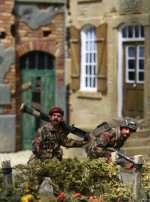
Six Victoria Crosses were awarded to members of the British and other Commonwealth armed forces for actions using the PIAT:[38]
- On 16 May 1944, during the Italian Campaign, Fusilier Frank Jefferson used a PIAT to destroy a Panzer IV tank and repel a German counterattack launched against his unit as they assaulted a section of the Gustav Line.[39]
- On 6 June 1944, Company Sergeant Major Stanley Hollis, in one of several actions that day, used a PIAT in an attack against a German field gun.[40]
- On 12 June 1944 Rifleman Ganju Lama of the 7th Gurkha Rifles used a PIAT to knock out two Japanese tanks attacking his unit at Ningthoukhong, Manipur (given as Burma in the official citation). Despite sustaining injuries, Ganju Lama approached within thirty yards (27 m) of the enemy tanks, and having knocked them out moved on to attack the crews as they tried to escape.[41] When asked by his Army Commander, William Slim, why he went so close, he replied he was not certain of hitting with a PIAT beyond thirty yards (27 m).[42]
- Between 19 and 25 September 1944, during the Battle of Arnhem, Major Robert Henry Cain used a PIAT to disable an assault gun that was advancing on his company position, and to force another three German Panzer IV tanks to retreat during a later assault.[43]

- On the night of 21/22 October 1944, Private Ernest Alvia ("Smokey") Smith used a PIAT to destroy a German Panther tank, one of three Panthers and two self-propelled guns attacking his small group. The self-propelled vehicles were also knocked out. He then used a Thompson submachine gun to kill or repel about 30 enemy soldiers. His actions secured a bridgehead on the Savio River in Italy.[44]
- On 9 December 1944, while defending positions in Faenza, Italy, Captain John Henry Cound Brunt used a PIAT, amongst other weapons, to help repel an attack by the German 90th Panzergrenadier Division.[45]
panda1gen
Lieutenant Colonel
- Joined
- Jul 29, 2005
- Messages
- 7,092
panda1gen
Lieutenant Colonel
- Joined
- Jul 29, 2005
- Messages
- 7,092
To continue from post #2,179
The plan formulated in England for the 4th Parachute Brigade Group was that it would move into Arnhem straight down the main road, the Amsterdamseweg, as soon as it was ready to do so. The brigade was to occupy the northern and eastern sectors of the town, handing over the eastern sector to the Polish brigade after its planned arrival on the following day. Not having heard any news before taking off, Brigadier Hackett did not know that the background to such plans was now out of date.
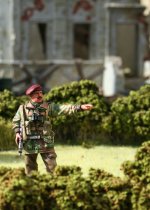
Only a small part of the 1st Parachute Brigade had reached its objective, and the remainder of that brigade was involved in desperate fighting. The divisional commander and one brigade commander were missing. Brigadier Hicks was acting in command of the division. Hicks had already decided to take away Hackett's 11th Battalion - the one whose rendezvous point was closest to the divisional area - and this news had to be broken to Hackett as soon as possible. Major Bruce Dawson, Hackett's brigade major who had brought the brigade's Advance Party in the previous day, had passed this order on to Hackett as soon as they met.
It was not long afterwards that Lieutenant-Colonel Charles Mackenzie, the GSO 1 (principal staff officer) at Divisional HQ, arrived to confirm the order that the 11th Battalion was to be detached.
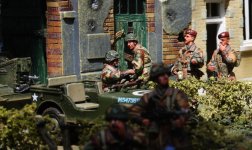
Ref: Arnhem - 1944: The Airborne Battle by M. Middlebrook
The plan formulated in England for the 4th Parachute Brigade Group was that it would move into Arnhem straight down the main road, the Amsterdamseweg, as soon as it was ready to do so. The brigade was to occupy the northern and eastern sectors of the town, handing over the eastern sector to the Polish brigade after its planned arrival on the following day. Not having heard any news before taking off, Brigadier Hackett did not know that the background to such plans was now out of date.

Only a small part of the 1st Parachute Brigade had reached its objective, and the remainder of that brigade was involved in desperate fighting. The divisional commander and one brigade commander were missing. Brigadier Hicks was acting in command of the division. Hicks had already decided to take away Hackett's 11th Battalion - the one whose rendezvous point was closest to the divisional area - and this news had to be broken to Hackett as soon as possible. Major Bruce Dawson, Hackett's brigade major who had brought the brigade's Advance Party in the previous day, had passed this order on to Hackett as soon as they met.
It was not long afterwards that Lieutenant-Colonel Charles Mackenzie, the GSO 1 (principal staff officer) at Divisional HQ, arrived to confirm the order that the 11th Battalion was to be detached.

Ref: Arnhem - 1944: The Airborne Battle by M. Middlebrook
panda1gen
Lieutenant Colonel
- Joined
- Jul 29, 2005
- Messages
- 7,092
The 7th King's Own Scottish Borderer companies came in from their isolated positions and were released by Brigadier Hackett, with his thanks for securing his brigade's dropping zone.

The second lift of the South Staffords, like the 11th Battalion, was on its way to rejoin its battalion fighting in Arnhem. The 1st Border retired from its exposed positions around the glider landing zone and moved towards Oosterbeek.

The Light Regiment moved more of its guns into the fields around the church in Lower Oosterbeek, though the last battery would not arrive there until later.
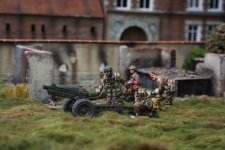
Divisional HQ. moved to the Hartenstein Hotel, yet another temporary move, it was hoped; its ultimate destination should have been the barracks of the old 'Yellow Riders' in Arnhem, which had not been bombed on Sunday so that they could be occupied by Major-General Urquhart and his staff.
Brigadier Hackett continued to direct the movements of his brigade for the next seven hours and found no time to visit Divisional HQ. Soon after 11.0 p.m. another officer messenger from Hicks found Hackett at his headquarters, which had moved to the Hotel Buunderkamp in the woods between Ginkel Heath and Wolfheze.
The officer was Major 'Jef' Linton, the commander of the Light Regiment battery supporting Hackett's brigade.
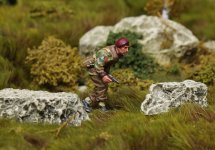
Linton had been summoned from the glider landing zone and told to convey a change of orders to Hackett. Hackett's brigade, for the first phase of its advance, was to make its objective a place marked on maps as 'Koepel', a ridge of high ground between the Amsterdamseweg and the railway about a mile outside the built-up area of Arnhem.

''Koepel' was not the name of the ridge, only of a private tea-house or gazebo, but the high ground was known as 'Koepel' by the airborne units, and the name is used here to describe it.
But Major Linton was unable to answer Hackett's questions about such things as timings and co-ordination with other parts of the division. Hackett now went to the Hartenstein to express to Hicks his anxieties and dissatisfaction at what he saw as 'an untidy situation'.

The second lift of the South Staffords, like the 11th Battalion, was on its way to rejoin its battalion fighting in Arnhem. The 1st Border retired from its exposed positions around the glider landing zone and moved towards Oosterbeek.

The Light Regiment moved more of its guns into the fields around the church in Lower Oosterbeek, though the last battery would not arrive there until later.

Divisional HQ. moved to the Hartenstein Hotel, yet another temporary move, it was hoped; its ultimate destination should have been the barracks of the old 'Yellow Riders' in Arnhem, which had not been bombed on Sunday so that they could be occupied by Major-General Urquhart and his staff.
Brigadier Hackett continued to direct the movements of his brigade for the next seven hours and found no time to visit Divisional HQ. Soon after 11.0 p.m. another officer messenger from Hicks found Hackett at his headquarters, which had moved to the Hotel Buunderkamp in the woods between Ginkel Heath and Wolfheze.
The officer was Major 'Jef' Linton, the commander of the Light Regiment battery supporting Hackett's brigade.

Linton had been summoned from the glider landing zone and told to convey a change of orders to Hackett. Hackett's brigade, for the first phase of its advance, was to make its objective a place marked on maps as 'Koepel', a ridge of high ground between the Amsterdamseweg and the railway about a mile outside the built-up area of Arnhem.

''Koepel' was not the name of the ridge, only of a private tea-house or gazebo, but the high ground was known as 'Koepel' by the airborne units, and the name is used here to describe it.
But Major Linton was unable to answer Hackett's questions about such things as timings and co-ordination with other parts of the division. Hackett now went to the Hartenstein to express to Hicks his anxieties and dissatisfaction at what he saw as 'an untidy situation'.
Users who are viewing this thread
Total: 4 (members: 0, guests: 4)


